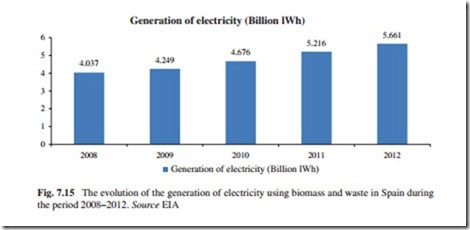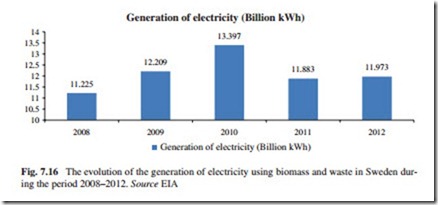Spain
Royal Decree 661/2007 established a FiT regime for the electricity production of each type of biomass. This decree also considers the possibility of cogeneration with traditional fuels. Thanks to this, the traditional thermal power plant introducing solid biomass or biogas production can sell a part of their production accord- ing to tariff from the special regime. However, it must be highlighted that this decree allows the producer to choose between selling the energy to the distributor in return for a specified flat tariff for all the scheduling periods or selling it directly on the day-ahead market or the futures market or through a bilateral contract. In these last three cases, the producer receives the negotiated price plus a premium. The choice must be made for at least a one-year term and communicated at least one month in advance to the responsible authority that will record the decision under the Administrative Register of Electricity Generation Installations. In addition, the decree establishes the right of the producer to sell all or part of the net production through direct lines. The energy sold through a direct line will not be governed by the economic regime set under this Royal Decree.
The NREAP (2010) for Spain proposes measures related to the subsidies for projects and actions with direct influence in the biomass sector in the country. In Spain, there are around 30 power plants with electricity production based on solid biomass, most of them being in Andalusia and Galicia. More than 60 % of electricity comes from power plants installed near industries, which consume electricity generated by their own by-products. Around 90 % are companies in the paper industry.
In Spain, the biogas industry has a great development in applications in landfill degasification. There are companies with international presence with experience in anaerobic processes of organic municipal waste.
In 2010, the biomass and waste installed capacity for electricity generation was 825 MW (533 MW of solid biomass, 115 MW of waste, and 177 MW of biogas). In 2012, this capacity reached 1,146 MW; this represents an increase of 38.9 % with respect to 2010. The total biomass and waste installed capacity represents 1.06 % of the total power capacity installed in the country and 2.71 % of the total renewable capacity installed in that year. The NREAP approved by the government estimates a total biomass and waste installed power capacity in 2020 of 1,950 MW (1,350 MW for solid biomass, 200 MW for waste, and 400 MW for biogas15); this represents an increase of 70.2 % with respect to the total biomass and waste capacity installed in 2012. In addition, small cogeneration units as well as power plants over 10 MW will play a significant role in the development of the sector during the period considered.
According to the biomass and waste power capacity installed, Spain occupies the place number 17 at world level with 1.43 % of the total and the place number 11 at regional level with 3.33 % of the regional biomass and waste capacity installed.
The total number of power plants using biomass and waste for the generation of electricity reached 203 in 2012. However, only two new biomass power plants have been commissioned in Spain since 2012 as instability in the country’s regulatory framework hits the sector. Between 2008 and 2012, there were 100 new installations commissioned in Spain. This took the country to a total of 201 operational power plants. But since 2014, the total amount of operational power plants had grown to just 203, with a total combined capacity of 863 MW. Sales of electricity produced from biomass amounted to 4,619 GWh, an increase of 10 % compared with 2012, but the rate of growth has slowed on previous years.
Generation of Electricity Using Biomass and Waste
The evolution of the generation of electricity using biomass and waste in Spain during the period 2008–2012 is shown in Fig. 7.15.
According to Fig. 7.15, the generation of electricity using biomass and waste in Spain during the period 2008–2012 increased 40.2 %. It is expected that the generation of electricity using this type of energy source will continue increasing during the coming years.

